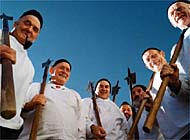How the neutral Swiss celebrate their military past

Although the Swiss pursue a policy of strict military neutrality, their fighting men were once among Europe most feared. Some of their victories continue to be celebrated even today.
On November 15, the people of Oberägeri and Sattel will feast the 685th anniversary of the Battle of Morgarten. With speeches, a parade and a traditional shooting contest, residents will commemorate what one organiser of the festivities calls “the first battle in Switzerland’s fight for freedom”.
Morgarten is a narrow pass between Zug and Schwyz which the Austrian army attempted to cross in 1315 on its way to attack Schwyz. The locals waited for the unsuspecting Austrians on the ridge above the defile, fell upon them as they marched through, and crushed and hacked them to death.
Today Switzerland is known for avoiding war. So it is hard to imagine the ferocity of the medieval Swiss who fought against the Austrians, Burgundians, Milanese and Germans – terrifyingly efficient foot soldiers armed with pikes and axes who defeated whole armies of mounted knights.
Morgarten marked the beginning of an extraordinary series of Swiss victories over much larger and stronger armies which ended 200 years later with Switzerland’s defeat by Francois I in Marignano.
Sempach, on July 9, 1386, was the battle that really put the fear of God – or, rather, of the common soldier – into Europe’s feudal nobility. On that battleground, the men of Lucerne, Uri, Schwyz and Unterwalden faced Leopold III of Austria and not only defeated his army completely but also killed the 35-year-old duke. It was the beginning of the end of Austrian rule in Switzerland.
In one skirmish after another, cantons won their independence; Näfels, the battle that freed Glarus in 1388, was perhaps the most significant victory to follow Sempach.
Today a chapel stands next to the Sempach battlefield. Nearby is a memorial to Arnold Winkelried, the battle’s legendary hero, who lunged at a formation of Austrian soldiers and deliberately impaled himself upon their pikes to open up a path of attack for the Swiss fighters.
The next major enemy the Swiss had to worry about was Charles the Bold of Burgundy, whom they managed to get rid of in a series of battles, two of which took place in Grandson and Murten in 1476.
Grandson doesn’t celebrate its role in the “Burgunderkriege”. Murten, however, holds its annual “Solennität” or “Solifest” on the battle’s anniversary day.
Giornico also ignores its victory there in 1478, when a rearguard of only 700 men protected the retreat of the Swiss army and put the 10,000-man Milanese army to flight. Dornach, on the other hand, proudly commemorates its victory 21 years later against the Germans.
“It was the last important battle to free Switzerland from Habsburg control,” explains Dornach’s Peter Jäggi, a retired teacher. Here, on July 22, 1499, men from Zurich, Bern, Solothurn, Zug, and Lucerne defeated Emperor Maximilian I and his army of German and Dutch mercenaries, ending both the “Schwabenkriege” and Maximilian’s dreams of reclaiming his ancestral seat in Graubünden.
Sixteen years later came defeat at Marignano, and with it the end of Switzerland’s role as a military power, although by no means the end of its men’s martial reputation since the Swiss continued to be the most sought-after mercenaries in Europe.
Three hundred years after Dornach, on March 5, 1798, the Swiss were to prove their military skill again, when Bern’s Sternenberg regiment defeated a Napoleonic brigade in Neuenegg. Napoleon still conquered Switzerland, but that hasn’t prevented the Neueneggers from celebrating their victory each year.
Although Swiss military triumphs are very much a thing of the past, there is still one concrete reminder of the extraordinary fighting talents of the medieval Swiss: the Pope’s Swiss Guard, founded in 1506 and still in service today.
by Kim Hays

In compliance with the JTI standards
More: SWI swissinfo.ch certified by the Journalism Trust Initiative
You can find an overview of ongoing debates with our journalists here . Please join us!
If you want to start a conversation about a topic raised in this article or want to report factual errors, email us at english@swissinfo.ch.